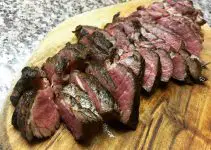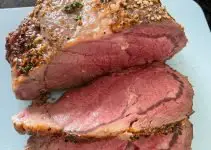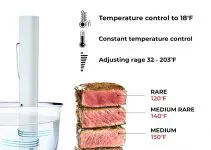Table of Contents
Using a sous vide bath is one of the best ways to defrost foods because it doesn’t affect the taste, and it can be done quickly and safely. But how do you defrost food in the sous vide?
This post covers the benefits of using a sous vide to defrost foods, how to defrost in a sous vide, and what to watch out for when defrosting.
Let’s dive in!
Why Should I Use The Sous Vide To Defrost Food?
While you can defrost foods without a sous vide circulator, other methods will affect the taste and texture.
During the defrosting process, the outside of your food will draw moisture and defrost while the inside remains frozen.
As moisture is lost, ice particles naturally move with it, damaging food at a cellular level. The more water your food loses, the more it’s damaged. This is why after defrosting something in the microwave, it tastes a little off.
So, in short, if you can defrost your food quickly and evenly, it’ll lose much less flavor and texture. This is what sous vide is best at.
Microwaves Don’t Defrost Properly
Microwaves will overheat the outside of your food while leaving the inside frozen. This sudden ice particle redistribution is the reason why food tastes drier and less flavorful after a quick defrosting.
Although defrosting food in the microwave is relatively safe, the USDA says it can bring meat into a danger zone where bacteria can multiply. This leads to food poisoning and bacterial infections.
Due to this bacterial threat, you should never defrost meat in hot water or by leaving it on the counter for hours. The USDA suggests defrosting it in the fridge since it’s safer than using a microwave. But who wants to wait that long when you can just pop it in the sous vide bath.
Sous Vide Is More Accurate
When putting your food in the refrigerator or microwave, you don’t control the exact temperature. This is why defrosting food can take a long time, and the inside will still be frozen while the outside is cooked.
But with sous vide, you control the exact temperature of your meal. This way, you won’t over or undercook it, leading to more accurate thawing.
It’s Better For the Environment
Because moving ice particles disturbs the structure of your food, the tastiest way to defrost meat is by leaving it under running water. The running water gently and evenly defrosts food, resulting in the best steak or fish possible.
However, this takes a lot of water and is bad for the environment.
Fortunately, sous vide does the exact same thing without wasting water. It recirculates warm water, protecting your food and the environment.
It’s Safer And More Time-Efficient
A 2011 study published by the Journal of Food Science found that defrosting food in a sous vide bath is the safest and fastest defrosting method. Proper thawing in a sous vide can even improve the texture and juiciness of your meal.
Sous vide defrosting is safe because it spends far less time at temperatures where bacteria thrive. This temperature range is 40°F to 140°F.
In terms of food safety, sous vide outperforms other defrosting methods like:
- Microwaving
- The cold water method
- Defrosting in a hot pan or pot
- Defrosting under cold running water
Now that we know the benefits of defrosting food in the sous vide, let’s look at how to defrost foods sous vide style.
How to Defrost Food in a Sous Vide Bath
Defrosting your food in a sous vide bath is quite simple. You can defrost almost anything in the sous vide. This includes:
- Steak
- Pork
- Fish
- Shellfish such as lobster
- Vegetables
- Chicken
- Frozen fruit
Once you’ve removed your food from the freezer, fill your sous vide tub with lukewarm water.
There are two approaches you can take when defrosting using a sous vide. You can defrost it fast and on high heat or slowly on low heat.
Personally, I like defrosting my food using higher heat. It’s much quicker, and it doesn’t allow bacteria to multiply. But there are benefits to defrosting foods slowly also. It defrosts more evenly, resulting in a more accurate steak.
If you’re opting for the faster approach, set your sous vide circulator to around 40°F for 30 minutes. In the same study by the Journal of Food Science, they found that this temperature range and time is safest.
If you have more time on your hands, setting your circulator to its lowest setting for one hour gives you an evenly defrosted steak.
Do I Need To Defrost Before Cooking In The Sous Vide?
Although you can cook foods in a sous vide without defrosting them, it becomes more difficult to control the temperature. But an easy way to combat this is to add 50% of the original cooking time. This prevents you from undercooking the inside.
This applies to many different foods. Just think of how easy and convenient it is to pop a frozen steak in the sous vide straight from the freezer!
What To Look Out For When Defrosting Food
Safety is the primary concern when defrosting food. Improper defrosting can lead to food poisoning. So here are some factors to watch out for to avoid bacterial growth.
Never Leave Foods At Room Temperature For Long Periods
Bacteria thrive at room temperature. When your food is in the freezer, sous vide or frying pan, they can’t survive and grow. So you want to keep foods at room temperature for as little time as possible.
Once you take it out of the freezer, immediately put it in the sous vide bath for defrosting. Never leave it on your counter for longer than a few minutes because it increases the likelihood of bacteria multiplying.
If you want to leave food out overnight, put it in the refrigerator.
Freeze Foods Immediately After Buying Them
Avoid leaving your meat on the countertop when you return from the grocery store. Put them immediately in the freezer since it prevents bacteria from growing. You should also avoid defrosting foods if you aren’t going to cook them immediately afterward.
Don’t Thaw Food In Hot Water
Whether you’re defrosting food in a sous vide or water bowl, avoid using hot water. If your food is above 40°F, it allows bacteria to grow. Although it might be a little more convenient, faster isn’t always safer. So use cold water and always set your sous vide circulator to below 40°F.
Final Thoughts on Defrosting Food with the Sous Vide
Sous vide produces the best meals every time. But you can use it for more than cooking steaks. Sous vide is one of the safest ways to defrost foods. It prevents bacteria from growing without affecting the taste and texture of your food.
When defrosting meals in the sous vide, take it out of the freezer and immediately put it in the warm bath. Set your circulator to below 40°F.
You also don’t have to defrost meats when cooking with sous vide. Simply add 50% of the original cooking time. So if you usually take one hour to cook a medium-well steak, add another 30 minutes to account for defrosting.






